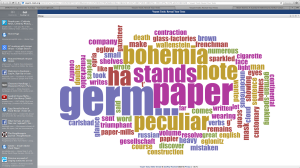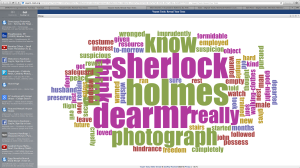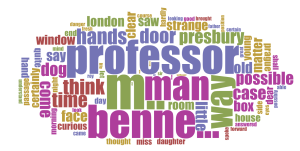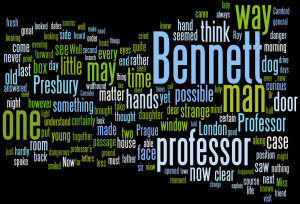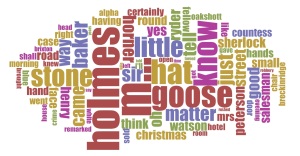While reading “The Speckled Band” I noiteced many things that Holmes does to try to get the reader, thinking as to what the answer to the mystery is. In this story a snake goes from a ventilator on a rope to another room where after many nights of landing on this person will eventually bite them and kill them. Holmes repeats numerous times that the bell rope was a dummy rope. With the constant repition you begin to think the rope plays a role in the mystery. Also Holmes talks about the ventilator many times bringing you to think something went through that ventilator, as a reader I assumed it was some sort of poisonous gas, but I soon realized Holmes would repeat other abnormalities that would imideatly change my thinking. Holmes would repeat that there was a small milk saucer in the room hinting at some sort of pet that Dr. Roylotts had. In general, Holmes repeats certain details of the mystery as he is solving it to help us the readers solve it ourselves. You could say the theme Holmes sticks with here is repeating the strange coincidences leaving it up to us to piece them together. Reading it for the second time and looking for key words or repetitive phrases I was able to piece the story together much faster. As I tried using word cloud for the first time I did struggle with how to make it stand out or match what I was trying to portray with it. For the first one I did a black background to represent the mystery took place at night, I made sure to include all the mysterious items Holmes finds and repeats throughout the story. What I noticed with the word cloud using worddle it was quite simple and with the different words bolder and in different colors it helped get a feel for the story and what pieces or people are important. I couldn’t really find any bad points with using worddle I thought it was rather easy and helped display information. What I did find difficult was voyant. With voyant I tried copying the text and I couldn’t work the site well enough so that it wouldn’t put in stopwords. Also with voyant I found it hard to personalize the information, but that could be because I’m not very tech savvy and couldn’t quite figure it out. In terms, of overall satisfaction with making a word cloud I very much enjoyed it. 

Voyant
Word Cloud: A Case of Identity
For this project, I decided to make some word clouds based off of the Sherlock Holmes story A Case of Identity. I thought that this project was a fun experience, and it’s definitely something that I’ll try using again. After listening to our guest speaker last class talk about graphic design and how to make our digital projects look more visually pleasing, I was excited to jump into this project. I first decided to make a word cloud using Voyant (as shown below).
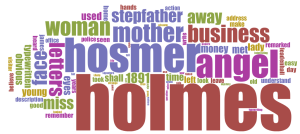 I was hoping that when I submitted my story, it would automatically turn out like this, but I had to make a few tweaks with the stop words before I got to this final result that I think turned out pretty well. I think that it emphasizes many of the core themes and major words that you need to know in order to get at least some idea of what the story is about. I don’t think this type of chart in general is the most easy to understand, but it’s visually appealing with the fun colors and the simple font. I also really liked how user-friendly the site was, and it wasn’t hard to make edits to it.
I was hoping that when I submitted my story, it would automatically turn out like this, but I had to make a few tweaks with the stop words before I got to this final result that I think turned out pretty well. I think that it emphasizes many of the core themes and major words that you need to know in order to get at least some idea of what the story is about. I don’t think this type of chart in general is the most easy to understand, but it’s visually appealing with the fun colors and the simple font. I also really liked how user-friendly the site was, and it wasn’t hard to make edits to it.
Unfortunately, my ancient computer couldn’t handle any Java or Silverlight updates, so I wasn’t able to use Wordle or Tagxedo. I’m still kinda bummed because I looked at the word clouds that other people posted and they look really cool. But I was informed of another word cloud website called JasonDavies.com (as shown below)
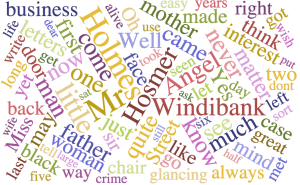 This word cloud is a lot more cluttered than the one from Voyant and I didn’t really enjoy using it. It only lets you change the font, which is a bit restricting when trying to make something look more visually appealing. And after using Voyant, it was a bit disappointing not being able to change anything other than the font. Most of the words are around the same size, so you can’t really tell which words are the most important. If someone who had never read the story before looked at this word cloud, I don’t think they would have a clue what the story was about.
This word cloud is a lot more cluttered than the one from Voyant and I didn’t really enjoy using it. It only lets you change the font, which is a bit restricting when trying to make something look more visually appealing. And after using Voyant, it was a bit disappointing not being able to change anything other than the font. Most of the words are around the same size, so you can’t really tell which words are the most important. If someone who had never read the story before looked at this word cloud, I don’t think they would have a clue what the story was about.
Word Cloud Project: A Scandal in Bohemia
Word clouds or tag clouds are visual depictions of word occurrence that offer greater importance to words that appear more frequently in a piece of text. Moreover, the larger the word is in the cloud, the more common the word was in the source of text.
For the word cloud project, I chose the Voyant word cloud generator and the Sherlock Holmes story called A Scandal in Bohemia. In the first word cloud that I have created, it shows what was happening at the beginning of the story when Sherlock Holmes receives a letter in the mail from the King of Bohemia who is asking Sherlock Holmes to do him a favor. During this part of the story, the words that show up the most often is paper, german, bohemia, stands, note, and peculiar. These key words help the reader to understand how the story obtained the title it was given because the word “peculiar” describes something unusual like a scandal is going on and the word “bohemia” describes the location that is involved in the peculiarity. Moreover, based on this particular word cloud, I learned that something peculiar is happening and somehow an individual from Bohemia is involved based on a note that Sherlock Holmes has received.
In the second word cloud that I developed, it shows what happened at the end of the story when Sherlock Holmes receives a letter from Irene Adler in regards to the most wanted photograph. During this part of the story, it is evident that some of the words that show up most often are Sherlock Holmes, photograph, know, dear, and really. These fundamental words help the reader understand that Sherlock Holmes did in fact find the photograph but failed to realize how stealthy Irene Adler really is.
Even though using word cloud can be an interesting and creative way to portray information, there are also some negative aspects of this tool. According to the Better Evaluation website, one of the pros of this tool is that there are various word and tag cloud generators that are freely available on the internet and creating them is really straightforward. However, based on the Nieman Lab article word clouds can be considered a negative tool because word clouds support only the crudest sorts of textual analysis. In addition, word clouds focus on only the occurrence of specific words instead of concepts and ideas that are important and will help you understand what is going on. Lastly, Word clouds leave the readers to figure out the context of the data by themselves because they have to translate what the jumble of words are trying to depict and explain.
Words Clouds: Form over Function
After reading an editor from the New York Times disparage the utilization of word clouds, I had similar thoughts running through my mind as I endeavored upon this assignment. What deep insight can be gained from tallying Arthur Conan Doyles’ choice of words? I chose his story A Scandal in Bohemia to investigate the importance of word clouds.
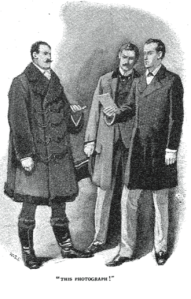
I began with Wordle, and then planned to also use Tagxedo for some word cloud fun. I chose these two based on the fact that Voyant‘s learning curve may have been longer because stop words would have to manually removed. I preferred to try to understand the first two applications thoroughly.
I found Wordle very easy to use, and yet complex enough to change the word clouds’ appearance fairly significantly. It removes the common words automatically, although you can adjust that, as well as the font, the colors (both background and the letters) and the layout. This final option dictates how many words are included, which direction they face, and if the cloud is round or jaggedly shaped.
I began with gray and black words with a white background, remembering the design principles from class last week. This was called the Ghostly color setting. I sought to add a touch of color, and chose the Heat setting. I found this to be the most pleasing combination I had found. Finally, I wanted to make a kaleidoscope of color to test the outer bounds of the application.
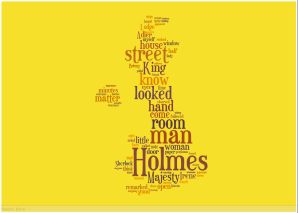
After learning a bit about the basics of word clouds, I hoped to create something more unique and memorable. The above word cloud was made with Tagxedo, using the sunset color scheme and aligned in the shape of Great Britain. One of the best features Tagxedo offers (which Wordle doesn’t) is the variety of shapes in which the words can be arranged. There were several geographic options, including Australia, South America and Great Britain, the latter of which was perfect considering Holmes London address. In addition to the options I did change, there were even more in the word/layout options menu on the left-hand side which I hope to investigate in the future.
Overall, this visualization tool can help to illuminate potential themes in a literary work. Photograph and Adler are two of many words that appear in the word cloud, making it clear that each is vital to the story. The confusion regarding the photo leads Doyle to increase the suspense, and Irene Adler’s name is used frequently because Holmes calls her the woman. The word cloud is simply another tool at the disposal of a digital humanities scholar.
I plan to try this with a yet-to-be decided text for exploration beyond Sherlock Holmes. Underlying themes can reveal themselves, or at the very least an artistic graphic can be created for a favorite piece of literature. Both design and literature interest me, so this was an intriguing assignment that I enjoyed thoroughly.
A Case of Identity Word Cloud
I used the visualization tool Voyant in order to create a World Cloud for the Sherlock Homes short story, A Case of Identity.
Since it is known that the World Cloud is a visualization of a Sherlock Holmes story, I added “Holmes” to the list of stop words, as well as “said.” These words, though used the most often, were irrelevant to the real analysis of the World Cloud.
Though little can be told about the plot of A Case of Identity from this visualization alone, it helps in pointing out who the story mainly revolves around. The words “Hosmer,” “Windibank,” and “Angel” appear 23, 20, and 19 times respectively throughout the text. Readers could infer that these are the main characters and upon reading the full text would discover that “Hosmer Angel” and “Windibank” are actually the same person.
Next to “Holmes,” which appeared 28 times in the text and was deleted from the Word Cloud, the next most often used word was “little.” This was surprising, as having read the text before creating this visualization, the word “little” seems to have nothing at all to do with the plot of the story. Upon further analysis, however, it can be seen that “little,” though not dealing much with the plot, is always used for a particular reason. Often times, it is used to describe Miss Mary Sutherland. Since she is a woman, she is portrayed as being more dainty, and therefore things about her are little, from her “little problem” to her “little handkerchief.” Watson also uses this term to describe Miss Sutherland’s appearance when Holmes asks him too, pointing out the “little black jet ornaments” on her jacket and the “little purple plush” on her dress. Holmes even goes as far as to comment on her “little income.” This use of the world little to describe Miss Mary Sutherland can be interpreted as a way to show readers that though it’s Miss Sutherland’s case that needs solving, Sherlock sees her as just another woman with a “little” and “trite” problem, and therefore, readers should see her this way as well.
While the comments Sherlock sometimes makes can be viewed undoubtedly sexist, I also think it’s important to look at the context of these stories. When Sir Arthur Conan Doyle wrote them, this generalization and view of women was the norm. It is only now, reading these stories in the 21st century, that we can point out what it is wrong with some comments made. Back then, this kind of description of women was not seen as an issue. It’s interesting to think, if Word Clouds were used long ago, if the same amount of analysis would be put into the word “little” or even how women were depicted in these Sherlock Holmes’ adventure stories at all.
Creeping man
I wanted to experiment with both tools, so above you can see the Voyant and Wordle visuals for the Sherlock Holmes story “The Case of the Creeping Man”. Each tool has its pros and cons. I like how with voyant you can see all the statistics and data behind eat word on the actual webpage and the fact you can add more stop words to customize what words appear. I wish it gave you the option to change the color and font. With wordle it’s just about the opposite. You have the option to change colors and font (though it’s very limited) but it doesn’t show much data behind the words. I did figure out that if you right click on a word, for example I right clicked on ‘Sherlock’ and it gives you the option to delete the word. So for my visualization I removed Sherlock and Watson so it wouldn’t take away from other key words in the story.
The visualization aspect is helpful about each tool, but I find it really doesn’t offer much information about the plot of the story. If someone were to look at these word clouds without having read the story before hand they would only understand that the larger words are the ones that come up most often and maybe gather some information about who the characters are in the story and the areas the story is taking place. I think Voyant is definitely more helpful and pays more attention to detail and statistics of the words. It is also helpful that you can edit the stop words and create your own stop word list. There is a lot to take in with Voyant but it’s nice that everything is all in one place: the word cloud, the actual text of the story, and the graphs for each word. The fact that it shows the words in context with the text is also very helpful.
Blog 1: Word Cloud
Word Clouds are graphic visualizations of the most frequent words used in a text. This tool allows fresh interpretations to be made about any texts. It provides a unique way of looking at a cluster of frequently used words that may elicit a different understanding of what is being presented.
I chose to closely read The Adventures of Sherlock Holmes: The Blue Carbuncle and create a Word Cloud to develop a new understanding and a fresh perspective on the story. I used Voyant as a tool to generate a Word Cloud for the text.
Below is a Word Cloud for the entire story:
The Blue Carbuncle
After editing the stop words and removing irrelevant words, the most common words to appear in the text are: man, holmes, hat, goose, little, know, stone, bird, and geese (beginning with most frequent word). These words make sense considering the premise of the story involves an investigation of the missing blue carbuncle in the neck of a goose. However I feel that this visualization and understanding of what is most important and valuable in the text would benefit from excluding similar words such as “goose” and “geese” and “bird”. I will edit the stop words to take away “geese” and “bird” and a few other less frequently occurring words that seem to be duplicates in one way or another to see how it strengthens my observation. In the new Word Cloud, there is a stronger sampling of frequent and presumably important words. The most frequent words are: man, holmes, hat, goose, little, know, stone, just, sir, baker, and tell. These words are a little more precise and reveal a lot about the plot of the story.
A quick browse through the word trends shows some information about where words more frequently appear in the text. The most frequently occurring word “man” appears scattered throughout the text in an even fashion. This makes sense since it is such a generic word. The top three words used commonly at the beginning of the text are: hat, goose, and stone. The top three words used more towards the end of the text are: holmes, little, and know. If I had no prior knowledge of the story I would analyze this information as a story starting out confidently and ending up a mystery. There seems to be a clear understanding with these frequent words that the beginning of the story is set up in such a way that is confident and outlining the premise. There are strong nouns that identify the main points and symbols of the story. It highlights what is most important. As the story progresses there are mysterious things happening. A case is being investigated by Holmes. The frequently used words that appear more often towards the end of the story are Holmes (noun), little (adjective), and know (verb). Holmes is solving the mystery of the Blue Carbuncle so naturally one would expect his name to appear at the end or resolution of the story. Interpreting the words as “Holmes knowing little” is another angle that could be looked at. Even though he does solve the case, the majority of the story is all about clues and small bits of information that are used as a collective whole to solve a mystery. These words and their placement in the text may be valuable in understanding the key points and themes of the story.
Using the Word Cloud platform and Voyant tool to analyze a Sherlock Holmes story is a fun and interactive way to read and understand the text. Being able to control what words should or should not appear in the Word Cloud, viewing the word trends, and seeing the frequencies are all helpful and can be used to extract important symbols or themes in the text that may have otherwise gone unnoticed.
Erica Gedney
Practice Post
Testing out the WordPress blogging platform and voyant visualization tool.
Click below for a word cloud of a story by Guy de Maupassant.
